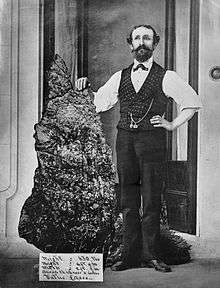Holtermann collection

The Holtermann Collection is the name given to a collection of about 3,500 glass-plate negatives which mainly depicts life in the New South Wales goldfields towns of Hill End, Gulgong, Home Rule and Canadian Lead.[1] Photographs of people and prominent landmarks are also included. The photographs were taken in the second half of the nineteenth century. The collection is held by the State Library of New South Wales.[2][3]
History
The 3500 wet-plate glass negatives in the Holtermann collection capture life in goldfields towns in regional Australia between 1872 and 1876, including the towns of Hill End and Gulgong, as well as Melbourne and Sydney in the 1870s.[4][5] The photographs were commissioned by Bernhardt Otto Holtermann and taken by Beaufoy Merlin and Charles Bayliss.[5][4] Producing the glass-plates was slow work. Long exposures were required and only one photograph at a time could be processed. Furthermore, the wet plate negatives captured exceptional detail, but photographs made after the discovery of the plates failed to reveal the wealth of information hidden within.
Rediscovery
In 1951 the negatives were discovered in a garden shed in Chatswood, New South Wales.[4] In response to an inquiry made by Keast Burke, then associate editor of the Australasian Photo-Review, to the Mitchell Library in Sydney, Burke was advised by the Mitchell Librarian that she had 'recently heard that the plates of photographs taken by old Mr. Holtermann' may be in the possession of the widow of Holtermann's youngest son. In the event, the collection of glass-plate negatives were in the garden room which had remained locked for many years. Thus the room disclosed its long-hidden treasures. The fortuitous timing of the advice to the library and Mr. Burke's inquiry, together Mr. Burke's ability to recognise the treasure and the chance safe-keeping of the plates for over seventy-five years, conspired to enable the conservation of this remarkable collection. In time, the find proved to be the most important photographic documentation of goldfields life in Australia.[6]
National significance
The national significance of the collection is due to its size and quality together with the level of detail captured in the images. It is a rare survivor of a large-scale nineteenth-century Australian photographic archive.[4] The collection includes one of the largest surviving wet-plate negatives in the world.[4]
In May 2013, the Holtermann Collection of glass plate negatives at the State Library of New South Wales was included on the UNESCO Memory of the World Register – Asia and the Pacific.[4]
Digitisation
In 2008, the collection was digitally scanned at very high resolution and, for the first time in over 100 years, it was possible to see with astonishing clarity what Merlin and Bayliss had actually photographed.[2]
In 2015, Gulgong Holtermann Museum was launched in Gulgong, NSW.[7]
References
- ↑ Downer, Christine (19 January 2015). "Photography in Australia: A select bibliography". History of Photography. 23 (2): 192–197. doi:10.1080/03087298.1999.10443822.
- 1 2 The Holtermann Collection, State Library of New South Wales.. Retrieved 6 June 2014.
- ↑ Neville, Richard (June 1999). "News". LASIE: Library Automated Systems Information Exchange. 30 (2): 56. Retrieved 7 April 2016.
- 1 2 3 4 5 6 "The Holtermann Collection". Australian Memory of the World. Retrieved 7 April 2016.
- 1 2 Johnstone, Richard. "How Merlin and Bayliss worked their magic". Inside story. Retrieved 7 April 2016.
- ↑ Gold and Silver: Photographs of Australian Goldfield from the Holtermann Collection by Keast Burke, Penguin Books Australia, 1973, pp 1–4.
- ↑ http://www.mudgeeguardian.com.au/story/2839026/gulgongs-holtermann-museum-launch-reveals-first-drawings/
External links
- The Holtermann Collection. State Library of New South Wales. Retrieved 6 June 2014.